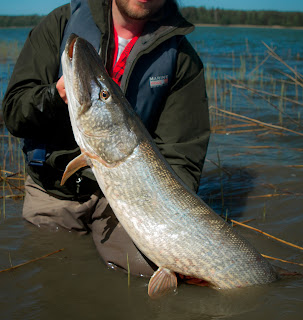Flatwing(ish)
I'm not sure if I can call this fly a true flatwing or not, but what I do know is that a fly like this has been kind to me. It's easy to make and very versitale in catching many different species of fish. They can be fished in rivers, lakes and oceans and seem to work for everything that eats minnows/baitfish. There's a shit load of movement in this type of fly. The compination of the bucktail and rooster hackle is unbeatable. No wonder that the fish are so turned on about this pattern.
 |
| A trio of flatwings with epoxy eyes. |
You can start off this article with this video:
in Youtube in Vimeo
It's my very first try at making a tying video.
And here's the Step-By-Step pictures:
 |
| Tie some white bucktail as our tail. Tie it big! |
 |
| Add some flashabou. |
 |
| Tie a long and wide rooster hackle on top of the tail. Silver doctor blue this time. |
 |
| Blue bucktail on top of the hackle. |
 |
| Dub the body with pearl wings and flash. |
 |
| Add white bucktail as a collar. Half way to the tail. |
 |
| Blue bucktail for the wing. |
 |
| Long and fine, black bucktail on top. Tied reversed. |
 |
| Nice! |
 |
| Finish it off with some peacock herls. |
 |
| In this case add some epoxy eyes and coat it with UV-glue. |
 |
| Finished product from the front. |
 |
| Finished product from the backside. |
Materials you need for this fly:
- Bucktail (variety of colors, with a focus on white)
- Rooster hackles. I like the grizzly colored ones, because they make wonderful bars to the back of the fly
- Flashabou
- Some kind of pearl or silver dubbing
- Peacock herls
- Jungle cock or epoxy eyes
- Good quality hooks in various sizes
Good quality bucktail is a must and by good quality I mean that the hair must be a bit hollow from the butt, stiff(ish) at the middle and soft from the top. This type of hair is very "big" when it hits the water and you can tie it pretty sparse. It's very hard to get tangled too, especially tied the way I do it.
For the rooster hackle you can use either the Flatwing saddles, American rooster saddles or American rooster capes. Whiting has some quality stuff. It's just sad that the supply of quality stuff is very thin. It's very hard to get good materials. You can actually leave the hackel (or hackles) out and make the same fly without any feathers. You can't just call it a flatwing any more, can you?...:) If your using cape feathers instead of saddle feathers, they make a bit stiffer and fuller tail/back to the fly then if your using the saddle feathers. The saddle feathers move better so it's a matter of what your looking for in a particular fly that should steer your choice.
My favorite hooks for these patterns are the Gamakatsu SC15, Sakuma 410 and the Mustad Stinger/Deer hair hooks. Choose the size according to your fishing and the fish that your after.
 |
| Hooks |
 |
| Sakuma 410 3/0, Gamakatsu SC15 2/0 and Mustad 1/0 Stinger hook |
 |
| Ready to bring some food to the table! |
'
On top of this pattern being very efficent, I think it's very beutiful and super fun to tie!
I hope this gets some of you in the groove of tying Flatwing(ish) flies. Please remember, I'm not the most technical tier and don't have much finesse in my tying. So don't learn my bad habits - you can do the same shapes, forms and movement with more finesse if you got the patience for it.
What I am pretty good at though, is making patterns that move and fish decently and thats more then enough for me. Have fun!!
 |
| Couldn't resist some fish porn. A nice Bluefish with a flatwing on her lips |
 |
| Cool, very cool... |
 |
| In it's right element. From the bench to the water. |























Remember to watch this clip as you check out the text: https://vimeo.com/55298086
ReplyDeleteYou get a pretty good picture of how this fly is tied.
Hí I´m David from Spain.
ReplyDeleteI like your blog, fly tying and fly fishing.
Greetings
www.romanillosflyfishing.com
Thanks David!
ReplyDelete